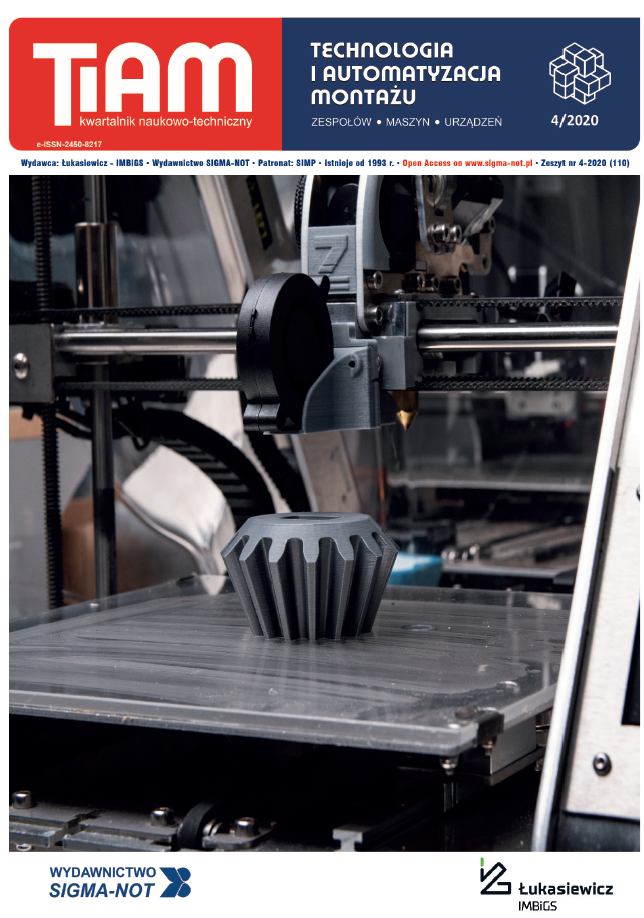Abstract
The article describes technological processes implemented during the production of accelerating structures for linear electron accelerators. In the production of accelerating structures, in order to obtain the expected final parameters of the electron beam, it is necessary to maintain very high accuracy of successive technological operations. Some dimensions of the resonance cavities constituting the basis of the structure should be in accordance with the design documentation, prepared on the basis of previously performed calculations and simulations with the use of programs solving partial differential equations, made with an accuracy of one hundredth of a millimetre. Additionally, due to the need to create a very high vacuum inside the structure the manufacturing of the structure, it is necessary during the production process to follow the cleanliness conditions of the works, specified by the technologist, for some technological operations. Time consuming production stages, expensive materials, complicated technologies using specialized machines and tools cause high costs and thus require the use of continuous inter-operational control. The article presents a new technological solution consisting in making cavities with higher tolerance of dimensions crucial for the electron acceleration process and connecting the cavities by brazing them together with other components of the accelerating structure in a way that guarantees the vacuum in the space where the electrons are accelerated. Until now, diffusion-connected resonators were inserted into a pipe made of stainless steel, which served as a vacuum jacket. The final part of the article describes the method of liquidation of vacuum leaks formed in the soldering process, which, when found, especially in the final stages of production, cause significant losses. It is, therefore, important to ensure that such damage can be repaired such a way that guarantees a vacuum during the entire life of the accelerator.
This is an Open Access article distributed under the terms of the Creative Commons Attribution License CC BY 4.0 (https://creativecommons.org/licenses/by/4.0/)
References
Baczewski A., Misiarz A., Kuciak Z., Salwa M., Terka M. 2020. „Stanowisko do badania parametrów struktur przyspieszających akceleratorów elektronów: wymagania i założenia”. Elektronika (4): 15-19.
Groszkowski J. 1978. „Technika wysokiej próżni”. Warszawa: Wydawnictwa Naukowo-Techniczne.
Hałas A. 2017. „Technika próżni”. Wrocław: Oficyna Wydawnicza Politechniki Wrocławskiej.
Kujawiński Ł., Politowski P., Gabryel R., Kowalska W., Buczek M. 2020. „Odgazowanie struktur przyspieszających liniowych akceleratorów elektronów w celu uzyskania bardzo wysokiej próżni”. Gaz, Woda i Technika Sanitarna (3): 19-21.
Misiarz A., Andrasiak M., Śmierzyński M., Andrasiak M., Piskorski M. 2020. „Automatyzacja procesu obróbki termicznej struktur M. przyspieszających do akceleratorów liniowych”. Elektronika (5): 6-9.
Misiarz A., Trzuskowski J., Latuszek M., Dymowska E., Kaczmarek M., Talarek Ł., Flis P. 2020. „Chłodzenie struktury przyspieszającej w liniowym akceleratorze elektronów płynami o niskiej temperaturze zamarzania”. Gaz, Woda i Technika Sanitarna (2): 18-20.
Sanchez L., Carrillo D., Rodriguez E., Aragon F., Sotelo J., Toral F. 2011. „Development of high precision joints in particle accelerator components performed by vacuum brazing”. Journal of Materials Processing Technology 211(8): 1379-1385.
Singh R., Pant K.K., Shankar L., Yadav D.P., Garg S.R., Raghuvanshi V.K., Mundra G. 2012. „Vacuum Brazing of Accelerator Components”. International Symposium on Vacuum Science & Technology and its Application for Accelerators. Journal of Physics: Conference Series 390 (2012) 012025.
Staszczak M. 2009. „Uzupełnienie do opracowania struktury przyspieszającej, pierwszego modelu akceleratora wysokospecjalistycznego – TOLERANCJE”. Świerk: Opracowanie wewnętrzne NCBJ.
https://laacg.lanl.gov/laacg/services/download_ sf.phtml (Program Superfish).
https://www.3ds.com/products-services/simulia/ products/cst-studio-suite/ (Program CST Microwave Studio).
https://www.qwed.com.pl/quickwave.html (Quick Wave).


